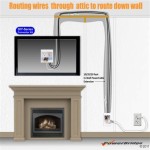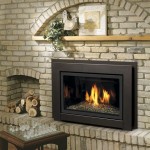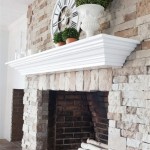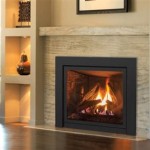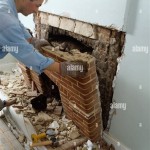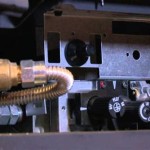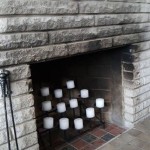Average Cost Of A Fireplace Insert
Fireplace inserts serve as effective and efficient heating solutions, designed to transform existing open fireplaces into reliable sources of warmth. Understanding the average cost associated with installing a fireplace insert involves considering various factors, including the type of insert, fuel source, installation complexities, and associated labor costs. This article aims to provide a comprehensive overview of the expenses involved in obtaining and installing a fireplace insert, offering a clear understanding of the financial commitment required.
The primary advantage of a fireplace insert stems from its capacity to significantly enhance the heating efficiency of a fireplace. Traditional open fireplaces often experience substantial heat loss up the chimney, rendering them inefficient heating appliances. Fireplace inserts, on the other hand, are designed to seal off the fireplace opening, preventing heat from escaping and directing it into the room. This enhancement translates into lower heating bills and a more comfortable indoor environment, particularly during colder months.
Furthermore, fireplace inserts offer greater control over heat output compared to traditional fireplaces. Many models come equipped with thermostats and blowers, allowing homeowners to regulate the temperature and distribute heat evenly throughout the space. This level of control contributes to energy savings and personalized comfort.
Before delving into the specific costs, it's important to differentiate between the various types of fireplace inserts available. The most common types include wood, gas, and electric inserts, each with its own set of advantages, disadvantages, and associated expenses. The choice of insert will significantly impact the overall project cost.
Cost Factors Influencing Fireplace Insert Prices
Several factors determine the final cost of a fireplace insert installation. Understanding these factors will enable homeowners to make informed decisions and budget effectively for the project.
Type of Fireplace Insert: The type of fireplace insert chosen—wood, gas, or electric—is a major determinant of cost. Wood inserts generally offer the most affordable upfront cost for the unit itself, but ongoing expenses associated with wood procurement, storage, and maintenance should be considered. Gas inserts tend to be more expensive initially, but offer convenience and ease of use, requiring a gas line connection. Electric inserts are typically the least expensive to purchase and install, but their heating capacity may be limited compared to wood or gas models.
Size and Heating Capacity: Fireplace inserts are available in various sizes and heating capacities, measured in British Thermal Units (BTUs). Larger inserts with higher BTU ratings are capable of heating larger spaces but come at a higher cost. Selecting the appropriate size and heating capacity for the area to be heated is crucial for both efficiency and cost-effectiveness. An oversized insert may lead to overheating, while an undersized insert may not provide sufficient warmth.
Brand and Features: Similar to other appliances, fireplace inserts are offered by various brands, each with its own reputation for quality, performance, and features. Premium brands often command higher prices but may offer superior construction, advanced features, and extended warranties. Features such as thermostats, blowers, remote controls, and decorative options can also influence the final price. Opting for a reputable brand and selecting features that align with specific needs and preferences is important for ensuring long-term satisfaction.
Installation Costs: Installation costs can vary significantly depending on the complexity of the project and the local labor rates. Factors that influence installation costs include the need for gas line connections, chimney modifications, electrical work, and the overall ease of access to the fireplace. Obtaining multiple quotes from qualified installers is recommended to ensure a fair and competitive price. A thorough inspection of the existing fireplace and chimney is essential prior to installation to identify any potential issues that may require additional work.
Chimney and Fireplace Preparation: Most fireplace insert installations require some degree of preparation to the existing chimney and fireplace. This may include cleaning the chimney, repairing cracks or damage, installing a chimney liner, and ensuring proper ventilation. The condition of the existing chimney can significantly impact the overall project cost. Older chimneys may require extensive repairs or even complete replacement, adding to the expense. A professional chimney inspection is crucial to assess the structural integrity and safety of the chimney system.
Permits and Inspections: Depending on local building codes, obtaining permits and scheduling inspections may be required for fireplace insert installations. Permit fees and inspection costs can vary by location. It is important to comply with all applicable regulations to ensure the safety and legality of the installation. Failure to obtain necessary permits can result in fines and require the removal of the insert.
Average Cost Breakdown by Insert Type
To provide a clearer understanding of the costs involved, a breakdown of the average expenses associated with each type of fireplace insert is provided below. These figures are estimates and can vary based on the factors mentioned previously.
Wood Fireplace Inserts: The average cost of a wood fireplace insert ranges from $1,500 to $4,000 for the unit itself. Installation costs typically range from $500 to $2,000, depending on the complexity of the project. Additional expenses may include chimney cleaning, repairs, and the installation of a stainless steel chimney liner, which can add $500 to $2,000 to the total cost. The ongoing cost of purchasing and storing firewood should also be considered.
Gas Fireplace Inserts: Gas fireplace inserts generally cost between $2,000 and $5,000 for the unit. Installation costs are typically higher than wood inserts, ranging from $1,000 to $3,000, due to the need for gas line connections. The cost of running a gas line to the fireplace can vary depending on the distance from the gas meter and the complexity of the installation. Venting requirements may also impact the overall cost. The operating cost of a gas fireplace insert is dependent on local gas prices.
Electric Fireplace Inserts: Electric fireplace inserts are typically the most affordable option, with unit prices ranging from $300 to $1,500. Installation costs are generally minimal, often requiring only an electrical outlet. However, the heating capacity of electric inserts may be limited compared to wood or gas models. The operating cost of an electric fireplace insert is dependent on local electricity rates.
Additional Considerations and Cost-Saving Strategies
Beyond the direct costs of the insert and installation, several additional considerations can impact the overall expense. Implementing cost-saving strategies can help to minimize the financial burden of the project.
DIY vs. Professional Installation: While it may be tempting to install a fireplace insert oneself to save on labor costs, it is generally recommended to hire a qualified professional. Improper installation can pose safety risks and potentially void the warranty. Professionals have the expertise and equipment necessary to ensure a safe and code-compliant installation. However, performing some preparatory work, such as cleaning the fireplace or removing debris, can potentially reduce labor costs.
Energy Efficiency and Rebates: Investing in a highly efficient fireplace insert can result in long-term energy savings. Look for models with high efficiency ratings and consider applying for energy efficiency rebates offered by local utility companies or government agencies. Rebates can help to offset the initial costs of the insert and make the project more affordable. Researching available rebates and incentives is a worthwhile endeavor.
Seasonal Sales and Discounts: Shopping for a fireplace insert during seasonal sales or off-season periods can potentially yield significant savings. Retailers often offer discounts on fireplace inserts during the spring and summer months, when demand is lower. Taking advantage of these sales can help to reduce the overall project cost. Monitoring retailers' websites and signing up for newsletters can provide advance notice of upcoming sales.
Financing Options: If the upfront cost of a fireplace insert is a concern, consider exploring financing options. Many retailers offer financing plans with low interest rates or deferred payment options. Obtaining pre-approval for financing can help to make the project more manageable and allow for spreading the cost over a longer period. Comparing different financing options is important to ensure the best possible terms.
Long-Term Cost Benefits: While the initial investment in a fireplace insert may seem significant, it is important to consider the long-term cost benefits. A fireplace insert can significantly reduce heating bills, increase home value, and provide a reliable source of warmth during power outages. The energy savings and increased comfort can offset the initial costs over time. Evaluating the long-term financial benefits is important when making a decision about investing in a fireplace insert.
In conclusion, the average cost of a fireplace insert varies depending on the type, size, features, and installation complexity. Thorough research, careful planning, and obtaining multiple quotes from qualified professionals are essential for making informed decisions and ensuring a cost-effective and safe installation. By considering the factors outlined in this article, homeowners can gain a comprehensive understanding of the financial aspects involved in obtaining and installing a fireplace insert and make choices that align with their budget and heating needs.

How Much Does A Gas Fireplace Insert Cost Forbes Home

How Much Does A Gas Fireplace Cost Fireplaces Direct Learning Center

Estimated Page Fireplaces Stoves Inserts Wood Gas Pellet

Estimated Page Fireplaces Stoves Inserts Wood Gas Pellet

How Much Does A Gas Fireplace Cost Fireplaces Direct Learning Center

How Much Does A Fireplace Insert Cost 2024 Data Angi

Gas Fireplace Cost Guide Unit Add Ons Installation More

How Much Does A Fireplace Insert Cost

2024 Gas Fireplace Insert Costs

Estimated Page Fireplaces Stoves Inserts Wood Gas Pellet
Related Posts

